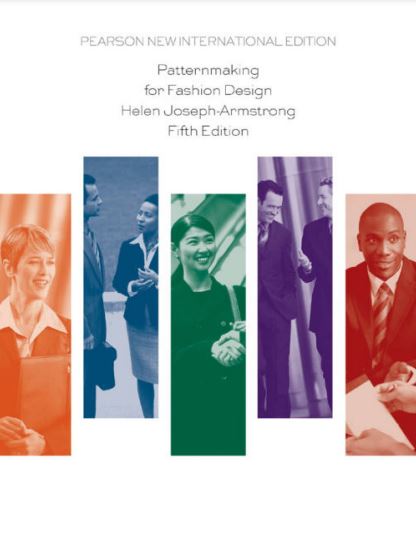‘Patternmaking For Fashion Design’ PDF Quick download link is given at the bottom of this article. You can see the PDF demo, size of the PDF, page numbers, and direct download Free PDF of ‘Fashion Design Patternmaking’ using the download button.
Patternmaking For Fashion Design PDF Free Download

PATTERN GRAINLINE
The pattern grainline is a line drawn on each pattern piece (from end to end) to indicate how the pattern should align with the lengthwise grain of the fabric.
Regardless of where the grainline is drawn on the pattern, it will always be placed on the fabric so that the grainline is parallel to the selvage edge.
Pattern placement is illustrated in Figure 1. The effect of grainline on garments is shown in Figures 2, 3, and 4.
Grainline Arrows
• Arrows placed at both ends of the grainline indicate that the top of the pattern may be placed in either direction along the lengthwise grainline of the fabric (for fabrics without a nap).
• An arrow placed at the top or the bottom of the grainline indicates that the pattern must be placed in one direction only (for fabrics with a nap).
DART
Bust point. A designated place on the bust and pattern and referred to in flat patternmaking as the pivotal point or apex (Figure 1). Dart.
A wedge-shaped cut-out in a pattern to control the fit of a garment when stitched. Dart’s legs.
The two lines converge at a predetermined point on the pattern. Dart intake. The amount of excess (or space) confined between dart legs.
Its purposes are to take up excess where it is not needed and to gradually release fabric where it is needed to control the fit of the garment.
SPECIAL INFORMATION
Right-side-up (when sides differ). The instruction applies to asymmetrical designs (the right side differs from the left side) and for patterns cut from engineered fabrics such as border prints, randomly spaced flowers, geometric forms, and multiple colors.
Such fabrics require specific pattern placement so that the fabric design can be arranged in the same location for all garments cut from that fabric.
Right-side-up (RSUP) indicates to the market maker that the pattern is to be placed face-up on the marker. Detail location.
Mark the location in which a detail is to be placed on the pattern. This will ensure that the flower, abstract detail, or stripes will always be on the correct side and in the correct place on the garment.
The Way We Were
Clothing has been manufactured in essentially the same way since the invention of the sewing machine in the mid-nineteenth century.
Old-fashioned, labor-intensive methods are still used by some small manufacturers and designers of custom-made apparel because they cannot afford technical upgrades.
Personal computers and inexpensive software are changing apparel design, and even small manufacturers can afford computer-assisted apparel production applications.
Today, more than 90 percent of apparel sold in America is manufactured off-shore. This reality has accelerated use
of computer-assisted apparel production methods and the Internet.
In the 1970s, grading and marker making was computerized, followed in the 1990s by large computer-aided design (CAD)
systems taking over patternmaking, fabric design, and design graphics.
Today, even the smallest manufacturer can rent hardware and software to assist the design and production processes.
Computer-generated patterns, markers, specifications, and cost sheets can be sent via the Internet to factories located around the world.
Though some jobs have been lost, designers, patternmakers, marker makers, graders, and cutters are still needed in this fast-paced business.
Computer companies offer seminars for students and current manufacturing employees to keep them updated on new technology. Fashion schools have added computer-assisted technology courses to their curriculum.
TukaTech set up Tukacenters in America as an innovation for students and those owning small businesses.
They can produce patterns and samples from designs using TukaTech software and have the patterns printed out at a local Kinko’s.
Another innovation by TukaTech and the Fashion Book Store is Fashion Project Café, which is housed in the Fashion Mart in Los Angeles, California. The project was conceived as an associated service for manufacturers large and small.
The service center leverages the most advanced technology in computer-aided pattern making, grading, and 3-D sewing that streamlines apparel production, reduces cost, and increases speed and quality to the market.
Even though American manufacturing is being outsourced to other countries, the entrepreneur can always find a niche in this dynamic industry that values change.
Fashion-savvy youth and innovative fashion leaders still demand innovative apparel. The mature customer searches for attractive garments that fit his or her changing figure.
Flexibility, research, and knowledge of a customer’s needs are the requirements of a successful apparel manufacturer of any size.
| Author | Helen Joseph Armstrong |
| Language | English |
| No. of Pages | 926 |
| PDF Size | 26 MB |
| Category | Art |
| Source/Credits | docs.google |
Related PDFs
Systems Analysis And Design Notes PDF
Patternmaking For Fashion Design PDF Free Download

how do I get this book